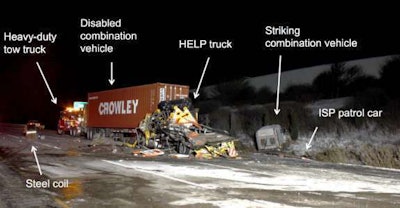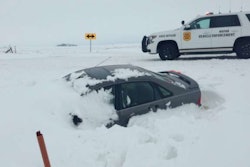
The National Transportation Safety Board held a meeting Tuesday Feb. 9 to determine a 2014 crash’s probable cause in order to finalize a report on and issue recommendations from the incident, which involved two tractor-trailers and resulted in the death of an Illinois State Toll Highway Authority truck driver.
A crash scene photo from the Illinois State Police.NTSB investigators presented their findings to the full board, which included trucker fatigue and logbook falsification, as well as “inadequacy of Federal Motor Carrier Safety Administration efforts to address the safety deficiencies of high-risk carriers or prioritize action to halt their operations.”
Reports at the time of the crash revealed that the truck operator in the case, Renato Velasquez, had been awake for about 35 hours prior to the crash and had driven over 1,000 miles in that time. He was also carrying falsified logs, FMCSA reported at the time.
NTSB will issue its final report based on Tuesday’s findings, along with recommendations as to how to prevent such a crash to regulators and the trucking industry.
The crash occurred when a DND International driver in a 2004 Freightliner and 2012 East flatbed carrying three steel coils collided with stopped vehicles in the right lane of I-88 in Naperville, Illinois.
According to the NTSB’s preliminary report, a 2000 Volvo tractor-trailer, owned by Michael’s Cartage, broke down in the right lane of I-88 around 7:45 p.m. An Illinois State Toll Highway Authority truck, along with an Illinois State Police patrol car, stopped behind the disabled truck to help the driver and warn oncoming traffic of the blocked lane.
At approximately 9:20 p.m., the DND driver collided with the ISP patrol car, pushing it off into the right shoulder and ditch. It then continued forward into the ISTHA truck, before going off onto the right shoulder and ditch itself.
During the collision, all three steel coils being transported by the DND truck fell off the flatbed. One of the steel coils made contact with the ISTHA truck and came to rest in the center lane of I-88. The other two steel coils came to rest in the ditch. The impact caused the ISTHA truck to collide into the back of the broken down truck, which in turn collided into the back of a heavy-duty tow truck.
A post-crash fire consumed the ISP patrol car, and the officer was severely burned but survived. The driver of the ISTHA truck was fatally injured and the right front passenger in the ISTHA truck, who was also the driver of the disabled truck, received minor injuries.
Investigators of the crash found that the DND driver had slept less than 4.5 hours in the 37 hours leading up to the crash, and said in their report to the NTSB board Tuesday that the driver admitted to falling asleep at the wheel. Investigators also found that the DND driver had falsified his logbook 36.9 percent of the time in the six months leading up to the crash.
The driver of the broken down vehicle was found to have false logs at the time of the crash, as well as preexisting vehicle defects that would have placed the vehicle out-of-service had it been inspected prior to the crash.
Both carriers were considered high-risk by the FMCSA at the time of the crash yet continued to operate despite FMCSA being aware of their noncompliance through Safety Measurement System data and compliance review results, NTSB says.
In 2013, the NTSB recommended the FMCSA be audited on its oversight capabilities of motor carriers and trucking companies, citing several major crashes in which carriers had previously been identified as at risk, yet saw no intervention by FMCSA.
NTSB investigators noted in their findings Tuesday that the recently-published electronic logging device rule and the proposed Safety Fitness Determination rulemaking would make it easier for FMCSA to regulate high-risk carriers.
The NTSB will publish a final report after changes and amendments are made to the investigators’ findings, which will include recommendations and all of the findings from the crash.










